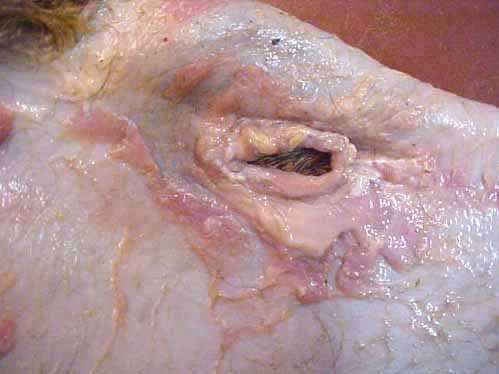
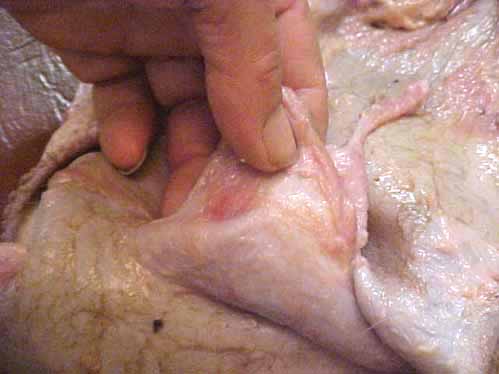
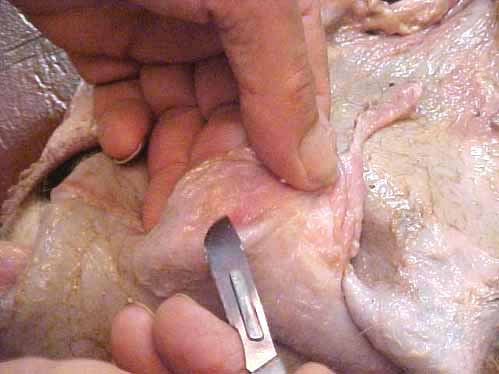
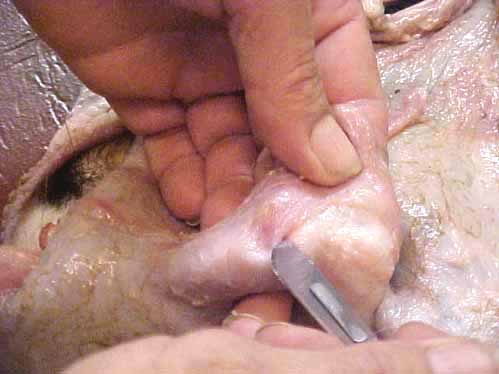
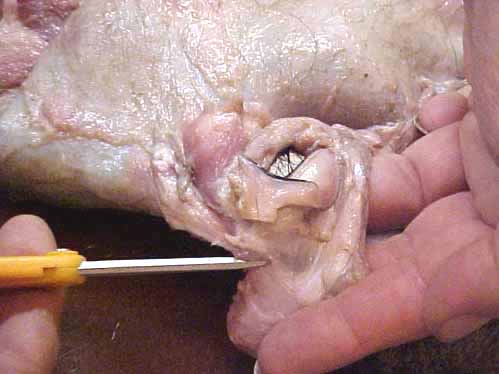
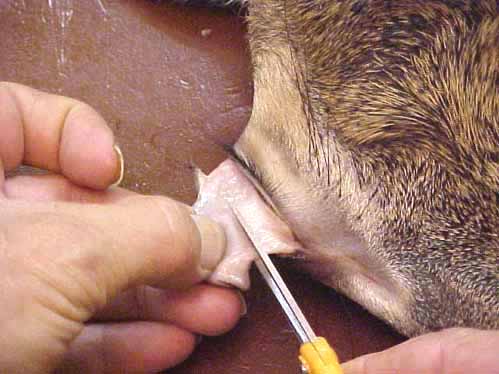
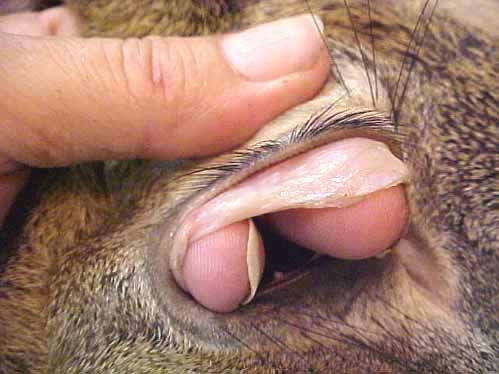
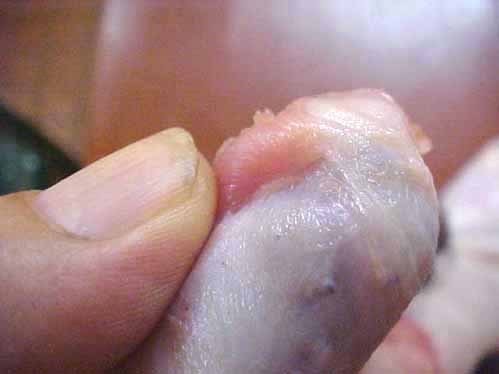
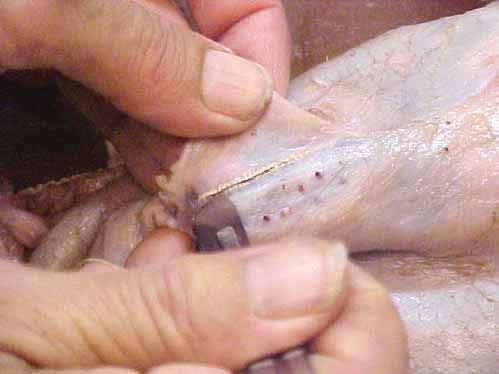
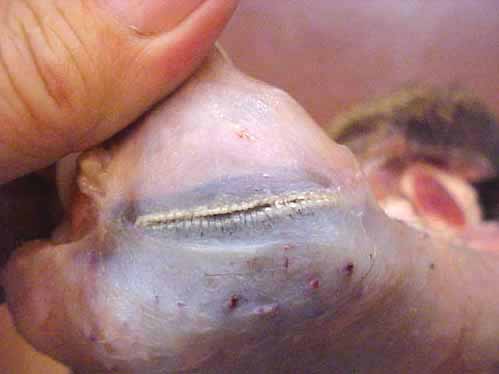
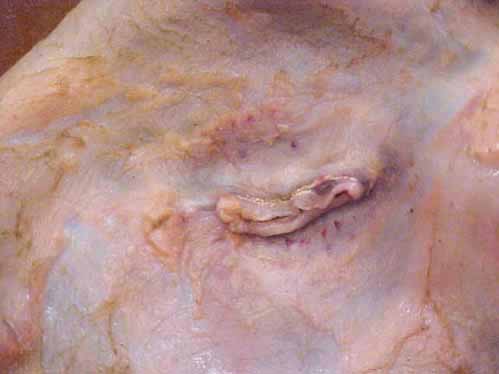
Split and Flesh Deer Eyes for Tanning and Taxidermy
by Glen Conley
If you are just getting ready to do your first deer cape I might suggest you invest in scapel blades and handles right up front. You can find them at most farm stores in the vet section, and that can get you started. If you are going to be using a number of blades, buying from the taxidermy suppliers will be much more economical.
I would suggest #15, #10, and #22 blades with their respective handles for starters. All three sizes in blades have their advantages. If you have never worked with scapels before, you will probably find the little #15 blade gives you the most control. You can work up in blade sizes as you become proficient.
Another thing to invest in is STOP-ROT and use it as directed. This will help to increase your odds of success and will also give you a longer work time. Your first go round on preparing a cape will probably be the slowest one you ever do and you will need every advantage you can get. The cape pictured in this series of detail fleshing articles was treated with STOP-ROT, that's why the glistening appearance to the flesh side of the skin.
In this first photo you are looking at the inverted head of a cape. All of the pink meat you see is to be removed. The areas around the eye can be tricky, so you had better be paying attention to what you are doing. Take your time and be SURE of what you are cutting off. You want to slice the pink meat away from the bluish/whitish/gray of the dermis. Pay attention to the "feel" of your scalpel in hand, the dermis will be firmer than the meat.
Pinch the meaty pieces up between your fingers. Feeling the difference between the muscles and skin will help you gain an idea of where to start cutting.
Once you get that first slice down to the dermis, it gets easier to figure out what you are doing. You'll be able to see the difference between meat and skin.
Now it is just a matter of continuing to separate the muscle from the skin until the muscle is cut free all around the eye.
Once you have worked all the meat off, including down and over the eye lids, start trimming the meat away from the lids. The little fine pointed scissors like you see here are made by Fiskars and they are available at about any department store, and they are a super good pair.
Once the big wads of meat are trimmed off, turn the cape hair side out again and pull the eye lid back through the opening. Trim off excess, but leave it just a little long at this time. You can always trim off more just before tucking the eye at mounting time.
Notice the hairless section of skin in the front of the eye, the front being toward the finger. The second photo down will show you what this looks like from the flesh side. This section of skin sits in the pre-orbital crease, and in the pre-orbital gland. Here is an outstanding live deer reference photo for this area.
Here's what things will look like at this stage of the game.
This is the flesh side view of the pre-orbital crease/gland area. Good place to use that little #15 blade. All the fine little muscles that you see have been cut back to a ligament that was anchored to the skull. You can see how tiny the ligament is, it is right below the muscles, and is that light colored cylindrical shape attached to the skin.
When you have cut the muscles free on the other side of the ligament, start trimming the muscles free of the ligament. Go slow, be sure of what you are cutting. The little fine point scissors come in handy at this time. Once all the muscles are cleaned off so that you can see this tiny ligament, you can play brain surgeon and cut the ligament free from the skin.
I do hope you haven't put your brain surgeon's hat away just yet, you're going to need it, we are going to split the eye lid next.
Before going further, take a look at the dark bumps on the brow. Those are the follicle sheaths for the tactile whiskers of the brow. You trim around those. If you cut the bottom of that "container" off, the whisker falls out.
Roll the eye lid around in your finger tips so you can get an idea as to how these skin layers will separate. They will be just a tad off center and terminate at the back side of the eye lashes. The sebaceous glands and eye lash follicles will feel like a cylindrical shape at this time. You want to aim your cuts at that cylinder.
I'm using a #10 blade here, but again, I might suggest you use the #15 for starters, you'll probably have less chance of error. I have cut down to the back side of the eye lashes, exposing the sebaceous glands.
Here's what you should be looking like when you are through with the surgery. You can either scrape the yellowish tissue free at this time, or wait until after the cape has been pickled. Often times it is easier to clean this area up after the pickle.
The front eye corner is to your left. You will see that the area in front of the eye corner is free of the muscles of the pre-orbital crease and gland. The ligament strip has also been removed.
You are now ready to move on.
More detail fleshing information.
WHITETAIL DESIGNER SYSTEMS offers our multi-step tanning system in kit form for the beginner or hobbyist that needs smaller quantities.
Kits are available through WHITETAIL DESIGNER SYSTEMS only and can be charged by phone. Toll free 1-877-861-5679.
HOBBY KIT
Contains 1 pint TAXIDERMIST'S LEATHERIZING ACID, 1 pint FAT·B·GONE, SHRINK-TONIC,1 pint CAM-L-C, pH papers and Instruction Guide. Enough for 3 average size whitetail capes or several small mammals!
$29.95 plus UPS shipping
DELUXE HOBBY KIT
Contains 1 pint STOP-ROT, 1 pint TAXIDERMIST'S LEATHERIZING ACID, 1 pint FAT·B·GONE, SHRINK-TONIC,1 pint CAM-L-C, pH papers and Instruction Guide. Enough for 3 average size whitetail capes or several small mammals!
$39.95 plus UPS shipping
SETTING EYES ON A REAL DEER FORM
STOP-ROT is available on-line from high lighted taxidermy suppliers!
1-800-843-3320, Wildlife Artist Supply Company 1-800-334-8012,
WHITETAIL DESIGNER SYSTEMS, INC.
Has made another expansion! WEB SITE SERVICES for taxidermists are now available!